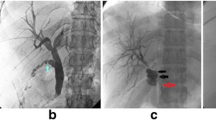Abstract.
Operations on the common bile duct can result in severe long-term consequences. To prevent some of these complications, it is common practice to drain the biliary tree with a T-tube. The T-tube is usually removed 2 weeks after it was placed. There have been numerous reports of bile leak following T-tube removal in the literature. These leaks can result in bile ascites, biloma, or bile peritonitis. Control of bile leaks can be accomplished in a number of ways, including endoscopically or radiologically placed stents or drains and radiologic techniques to drain the fluid collections. We describe a novel technique that can be utilized at the time of T-tube removal that will allow immediate control of the bile leak and prevent the complications of bile accumulation within the peritoneal cavity. We have performed fluoroscopic removal of T-tubes on two patients and found no complications with the technique. We have successfully visualized the T-tube tract in both patients. The T-tube tract can be visualized at the time of T-tube removal in an effort to prevent the complications of tract disruption and subsequent bile leak.
Similar content being viewed by others
Author information
Authors and Affiliations
Additional information
Received: 25 October 1996/Accepted: 25 February 1997
Rights and permissions
About this article
Cite this article
Jacobs, L., Shayani, V. & Sackier, J. Common bile duct T-tubes. Surg Endosc 12, 60–62 (1998). https://doi.org/10.1007/s004649900595
Published:
Issue Date:
DOI: https://doi.org/10.1007/s004649900595



